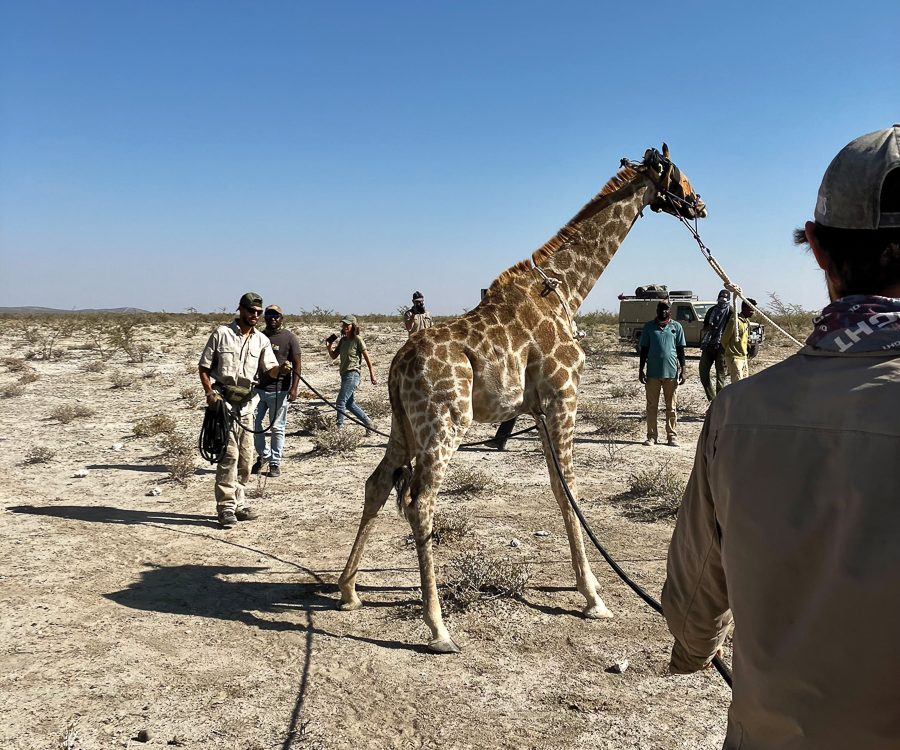Namibia Rainfall summary
May 22, 2013At play in the Namib-Naukluft
May 22, 2013By Nita Pallett
The road is long and winding, the landscape dry and scattered with loose red rocks and Euphorbia. Tall mountains litter the landscape.
The cars inch their way forward as the sun stretches across the sky – everything about this place screams vastness. Sharp eyes scan the scenery intently, not allowing anything to pass them by. We drive on past the giraffe and her baby, past the spotted hyena, past the zebra with their quizzical faces. Finally, we see it – our dinosaur of the desert, the reason for this expedition – a lone Diceros bicornis bicornis; the desert-dwelling black rhino.
Eagerly, we all leap out of the vehicles and begin to make our way towards our rhino. At our final vantage point the trackers get to work with the identification booklets. The work goes smoothly; the rhino seems not to have noticed our presence as we click away with our cameras. Once he’s out of sight, we head back down to the cars. The atmosphere out there is amazingly peaceful, but yet as we drove, a feeling of uneasiness crept up the back of my mind, as I wondered how much time these creatures may have left.
Throughout Africa, rhinos are being poached to such an extent that we fear for the species’ survival. In South Africa, a rhino is poached every 10 hours, and its horns are sent off to some faraway country where it is sold for amounts of money inconceivable to most. This market is a dangerous one; the methods that the poachers and their syndicates use are so incredibly sophisticated. They are almost impossible to stop.
Namibia however has a unique approach to wildlife conservation, which has proved to be our saving grace so far – the communal conservancies, and the Save the Rhino Trust (SRT).
The conservancies provide a possibility for local people, who live with the wildlife, to benefit financially from protecting it. Rhino tracking tourism and other tourist activities of a similar nature are highly sought after by many people across the globe. These activities generate generous amounts of money for the people who treasure and look after our natural assets.
On top of the financial gain from tourism, there is a feeling of pride toward having these pachyderms, and it has been statistically proven that rhino are seen as an valuable benefit for the communities.
During our visit to Mai Go Ha, the SRTs base camp, we had the opportunity to talk to people from the ǂKhoadi //Hôas conservancy, and we were all thoroughly and proudly impressed! They are one of the first conservancies to reintroduce rhino to their area, and have done this successfully and continue to monitor the rhino and all the other wildlife extensively.
The excursion to see the rhino was just a quick glance at a ‘day in the life’ of the people protecting the largest worldwide population of free-roaming black rhino; the extent of their work and past accomplishments speaks for itself.
After the poaching crisis in the 70s, the SRT managed to protect the rhino to such an extend that the population grew from less than 60 individuals to almost five fold that number. The SRT will continue to protect them as long as the funds and support from Namibians and international donors allow them to do so. As we departed from the rhino we had observed, I was in awe of its existence. More so, I was in awe of the work the SRT does and of all I had seen and experienced over the weekend, and would like to send out a special ‘thank you’ to all these people for helping save Namibia’s rhino.
About the writer: My name is Nita Pallett; I am 17 years old, and a student at the Waldorf School Windhoek, currently in grade 12. I am completing a final year project on the conservation of rhino in southern Africa, focusing mainly on Namibia.
Growing up in Namibia has been a wonderful life; I have leant to love every corner of it. Protecting our environment and all our wildlife is something I feel very strongly about, and I hope to contribute to it once I finish school. I love horse riding, music, and being in the outdoors.





1 Comment
Nice Post.